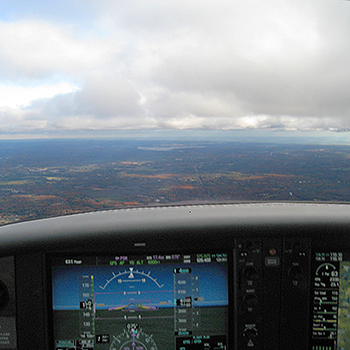Subscriber question:
"I've flown behind a basic six-pack and GPS navigator for decades and am now checking out in the same model airplane but with a G1000. My instructor is constantly reminding me to look outside. I never had this problem before. Why is this so different with the glass cockpit?" — Mark C.
Penny:
 “We all develop what are called ‘habitual behavior patterns.’ We have ways of interacting with something, and then we do the same thing in the same situation over and over. So, our habitual behavior pattern when we interact with screens typically involves staring at them for extended periods of time. Think about your work computer or scrolling social media on your phone. When we get into the aircraft, it’s easy to fall into the same pattern and become absorbed with the flight displays and lose situational awareness. That’s true of a glass panel or just an EFB or a tablet. Failure to consistently scan outside of the aircraft is common.
“We all develop what are called ‘habitual behavior patterns.’ We have ways of interacting with something, and then we do the same thing in the same situation over and over. So, our habitual behavior pattern when we interact with screens typically involves staring at them for extended periods of time. Think about your work computer or scrolling social media on your phone. When we get into the aircraft, it’s easy to fall into the same pattern and become absorbed with the flight displays and lose situational awareness. That’s true of a glass panel or just an EFB or a tablet. Failure to consistently scan outside of the aircraft is common.
Loss of situational awareness is a common cause of aviation accidents, and fixation on all the information a digital display offers can be just as dangerous as fixation on a minor aircraft problem, a specific instrument, or a distracting passenger.
Habitual behavior patterns aren’t all bad. Think of aircraft pre-flight or prepping an approach. Repeated actions can build efficiency and reduce errors.
So, minimize your fixation issues by building the right habit patterns. First, be thoroughly familiar with your displays—including your EFB—before flying. The more time spent searching for the right button or screen, the less time you have to look outside. Simulators and dry time with a ground power unit are great ways to master a technologically advanced aircraft that you have not flown before. Be sure your EFB is updated and you can easily locate the features you need. Many EFBs can connect to a home simulator so you can let the sim do the flying and use the EFB as if you were in the airplane.
When you get into the airplane, build the habit pattern you want. Practice minimal interaction with your screens in flight with conscious breaks between long inputs of data or knob turning to just look outside and fly. Place your EFB where it is in your line of sight for the windscreen without blocking your view. Finally, resist the temptation to use any personal devices not needed for the flight.”
Here are some more tips for using glass cockpits from our online course “IFR: The Missing Lessons”.
Do you find you spend more time looking inside the airplane when flying with digital displays?
(This could be a glass panel or just a tablet EFB.)

